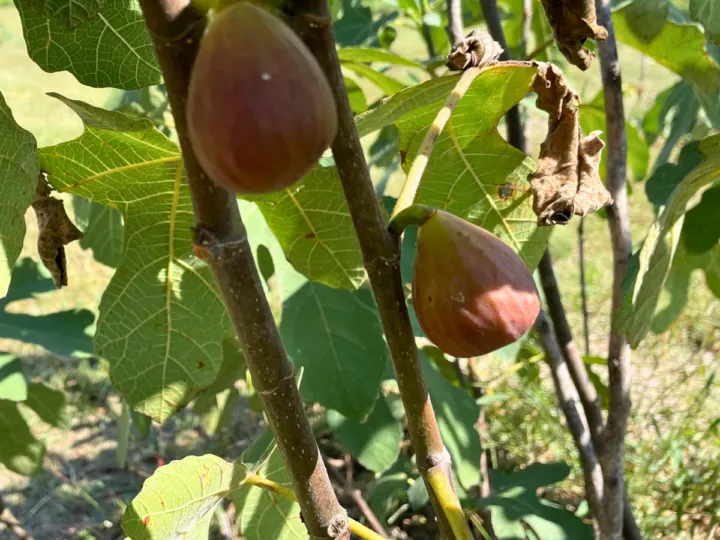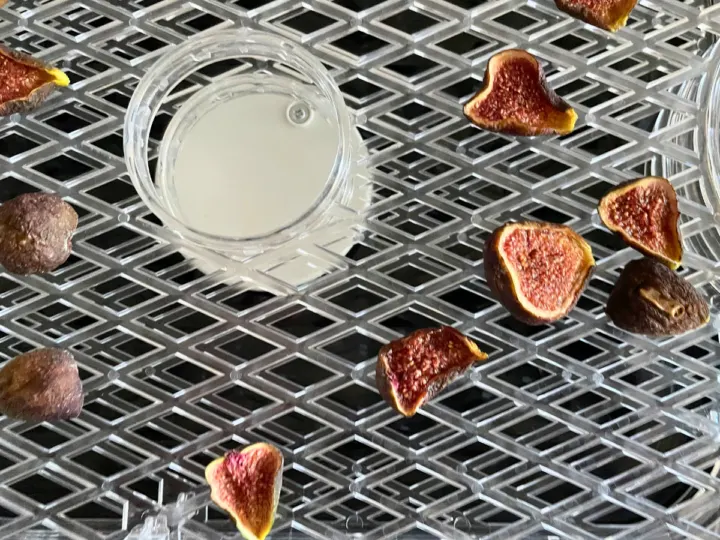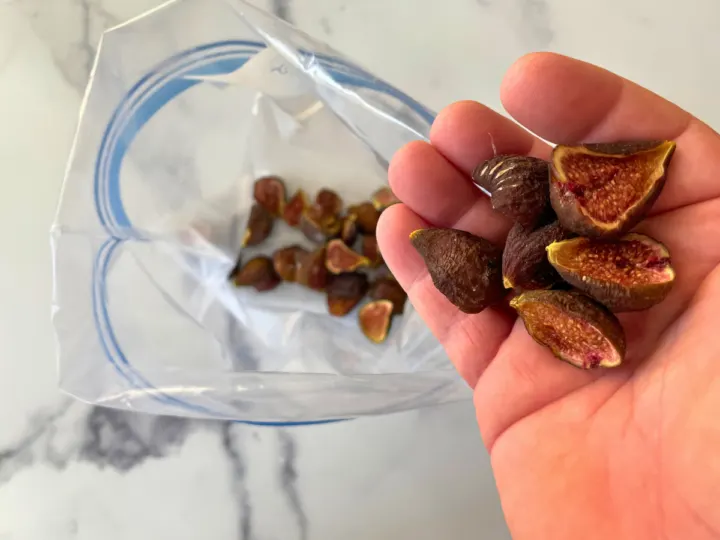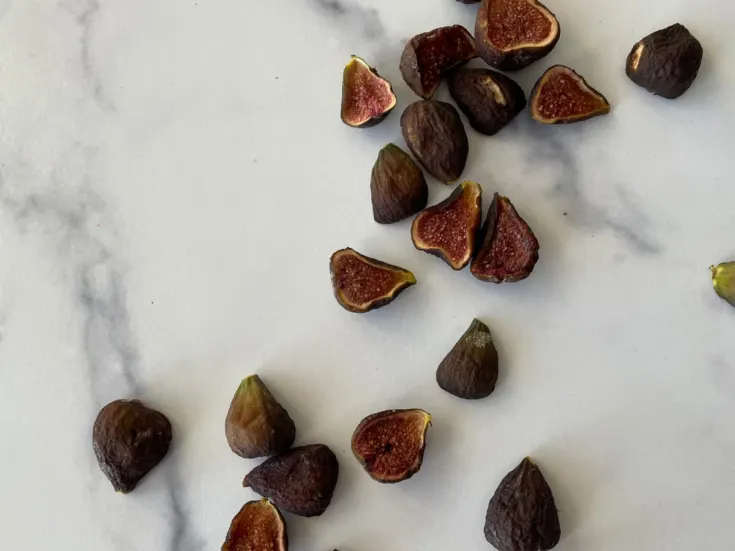Dehydrating fresh figs at home is a delightful and practical way to preserve the sweet and succulent flavors of this seasonal fruit for year-round enjoyment. Whether you have an abundance of fresh figs from your garden or simply wish to savor their unique taste long after the harvest season, the process of dehydrating figs is surprisingly simple and rewarding.

In this step-by-step guide, we will walk you through the process of transforming plump, ripe figs into a delicious, shelf-stable snack that can be used in various culinary creations. By the end of this tutorial, you’ll have a batch of dehydrated figs ready to add a burst of natural sweetness to your dishes, making them an excellent addition to your pantry.
So, gather your fresh figs, and let’s embark on this journey of turning this exquisite fruit into a delightful, preserved treat.
What is Dehydrating?
Before we can look at dehydrating figs, we must first look at why we dehydrate foods and what dehydrating is in the first place. Dehydrating is a drying process that takes the moisture out of the food. The reason you may wish to dehydrate foods such as fruits or meats is to preserve them for eating later on.

Dehydrating foods is one of the oldest forms of food preservation. The history of dehydrating foods dates back thousands of years and has been an important method of food preservation across various cultures. Back then, ancient civilizations would dry food in direct sunlight to remove the moisture so food would last. It was an important part of living. Fast forward to modern times, people still love dehydrating food to preserve it.
Here are a few more reasons why you may want to dehydrate food:
- Prolonged Shelf Life: Dehydrating food reduces the water content, which inhibits the growth of bacteria, yeasts, and molds that cause spoilage. This allows food to be stored for an extended period without refrigeration.
- Reduced Weight and Volume: Removing moisture significantly reduces the weight and volume of the food, making it more convenient for storage and transportation, especially for hikers, campers, and those in emergency preparedness situations.
- Reduced Food Waste: Dehydration is an excellent way to preserve surplus or excess produce when fruits and vegetables are in season. It prevents them from going to waste and allows you to enjoy them throughout the year.
- Nutrient Retention: When done properly, dehydrating food can retain a majority of its nutritional value, including vitamins and minerals. While some nutrients may be lost in the process, it’s often a more nutrient-dense option compared to other preservation methods.
- Convenience: Dehydrated foods are lightweight and portable, making them convenient for outdoor activities like camping, hiking, and backpacking. They require minimal preparation and cooking, as rehydration can be as simple as adding hot water.
- Improved Flavor: Dehydration can concentrate the flavors of food, resulting in an intense and sometimes sweeter taste.
- Homemade Snacks: Dehydrating allows you to create your own healthy, preservative-free snacks like fruit chips, jerky, or dried herbs.
- Emergency Preparedness: Dehydrated food is a staple in emergency preparedness kits as it can provide a source of nutrition during disasters or when access to fresh food is limited.
Common foods that are often dehydrated include fruits, vegetables, herbs, meats (for jerky), and even cooked grains or pasta. Dehydrating food can be done using various methods, including air drying, sun drying, oven drying, or using specialized food dehydrators.
Figs Are A Perfect Fruit to Dehydrate
One of the downfalls of figs is it is a delicate fruit, and lacks good shelf stability. This is why you seldom find them on grocery store shelves; they simply don’t withstand shipping and storage.

Consequently, dehydrating figs emerges as the ideal solution. By dehydrating these fruits, you not only increase their longevity but also secure a supply for future use, particularly during bumper harvests.
Growing up in the South, there are many common fruits and veggies you see around a homestead.
We moved to the place that I called home for 26 years when I was 4 years old. As stated in my Muscadine Jelly Recipe, a few things were present when we showed up. One of those things was a muscadine trellis with a huge vine and also a couple of fig trees.

I loved going out there to pick fresh figs from the tree and eat them. But you can only eat so many fresh figs before they start to get overripe.
If you own fig trees, you’re likely familiar with the annual abundance of ripe figs. Fig season is short-lived and a bunch seem to ripen all at once. So they make the perfect fruit to dehydrate for future use.
Best Variety of Figs to Use
When it comes to dehydrating figs, some fig varieties are better suited than others due to their flavor, texture, and overall characteristics. Here are a few fig varieties that are considered excellent for dehydrating:
- Black Mission Figs: Black Mission figs are one of the most popular fig varieties for drying. They have a sweet and rich flavor, and their dark skin adds a beautiful color to the dried figs.
- Calimyrna Figs: Calimyrna figs, also known as Turkish figs, are another excellent choice for drying. They have a nutty and slightly honeyed flavor that intensifies during the drying process.
- Brown Turkey Figs: Brown Turkey figs are a versatile fig variety and are good for both fresh consumption and drying. They have a sweet and mild flavor.
- Adriatic Figs: Adriatic figs, also known as White Kadota figs, have a honey-like sweetness. They dry well and maintain a delicate flavor.
- Kadota Figs: Kadota figs are another variety with honey-like sweetness and make excellent dried figs.
- Texas Everbearing Figs: These figs are known for their exceptional sweetness, which is enhanced during the drying process. They are particularly well-suited for making dried figs.

When selecting figs for drying, it’s essential to choose ripe figs that are not overly mushy. Ripe figs are sweeter and more flavorful, which will result in better-tasting dried figs.
Ways to use Dried Figs
Dehydrated figs are a versatile ingredient that can be used in a variety of culinary applications. They have a sweet and concentrated flavor, making them a great addition to both sweet and savory dishes.
Here are some ways to use dehydrated figs:
- Snacking: Dehydrated figs make for a delicious and nutritious snack on their own. Simply eat them as a healthy alternative to candy or other sugary treats.
- Rehydrate and Use in Baking: You can rehydrate dehydrated figs by soaking them in warm water or fruit juice for about 30 minutes. Once they are plump and soft, use them in baking recipes such as fig muffins, fig cakes, fig cookies, or fig bread.
- Trail Mix: Combine dehydrated figs with nuts, seeds, and other dried fruits to create your own customized trail mix. It’s a great energy-boosting snack for hiking or on-the-go.
- Breakfast: Chop or slice dehydrated figs and add them to your morning oatmeal, yogurt, or cereal for a sweet and fruity twist.
- Salads: Rehydrated and chopped figs can be added to salads for a sweet contrast. They pair well with greens, nuts, cheese, and vinaigrette dressings.
- Cheese Platter: Dehydrated figs are a popular addition to cheese platters. They complement a variety of cheeses, including goat cheese, blue cheese, and brie.
- Compotes and Chutneys: Simmer dehydrated figs with water, sugar, and spices to create a fig compote or chutney. These can be used as condiments for meats, cheese, or as a spread.
- Smoothies: Add a few dehydrated figs to your smoothie for a natural sweetness and flavor boost. They work well with ingredients like yogurt, bananas, and spinach.
- Stuffing: Chopped or rehydrated figs can be used as part of a stuffing for poultry, like chicken or turkey, or in vegetarian stuffed peppers.
- Marinades and Glazes: Blend rehydrated figs with other ingredients to create a flavorful marinade or glaze for meat or vegetables. This is especially delicious for roasted or grilled dishes.
- Fig Bars: Make homemade fig bars by blending rehydrated figs and spreading the mixture between layers of pastry or oat-based dough. Bake until golden brown.
- Fig Jam or Spread: Simmer dehydrated figs with sugar, lemon juice, and a little water to create your fig jam or spread. Enjoy it on toast, in sandwiches, or as a condiment for various dishes.
- Desserts: Incorporate dehydrated figs into desserts like rice pudding, panna cotta, or ice cream for a sweet, fruity addition.
- Energy Bars: Make homemade energy bars by blending rehydrated figs with nuts, seeds, and other healthy ingredients. Press the mixture into a pan, chill, and cut into bars.

Experiment with these ideas to find the best ways to incorporate dehydrated figs into your favorite dishes and discover new flavor combinations.
How To Dehydrate Figs
Before we begin, you will need a few tools and ingredients. The most important tool is a dehydrator. You can use an oven, but a dehydrator works best for this method.
Ingredients:
- Fresh Whole Figs
Tools:
- Knife
- Large Pot
- Wire Strainer
- Glass Jars or Airtight container
- Tea Cloth
- Parchment Paper
- Food Dehydrator: See Below for more information
Note: To see a created list of items and brands we recommend for canning and preserving, check out our dedicated page here.
Food Dehydrator Information
There are many dehydrators on the market from the very basic to commercial units. A basic one will do but the issue with them is they are hard to control the temperature and time. The more fancier dehydrators have more bells and whistles that help make this job easier.
The very basic dehydrator heats from the bottom as the more expensive ones heat from the back. This method tends to provide more even heat distribution. If the unit heats from the bottom, the trays closest to the bottom will dehydrate faster so it is important to rotate your trays every few hours if that is the type you have.

Also, the more expensive units have temperature control and this is important if you plan to use the dehydrator for other foods such as meat which requires a higher temperature than fruit or herbs.
The last thing to consider is time. The more expensive units can be set to run a certain time, after that they cut off. This is a nice feature to have to keep from over-dehydrating your food.
Here are my recommendations for a dehydrator from least expensive to most:
- Basic dehydrator: This unit heats from the bottom but does have an adjustable heat setting. It does not have a timer setting.
- Middle-of-the-road dehydrator: This is the unit that I use at the moment. This unit has digital control for heat and has a time setting. The downside is it heats from the bottom.
- Dehydrator with bells and whistles: This is the Excalibur Dehydrator and the one that I would personally buy if I were to buy a new one. They are highly recommended, heat from the back, have stainless steel trays with small holes in them, digital temp setting, and timer control. They are also highly recommended amounts for most homesteaders and people who preserve food.
Washing and Inspecting:
Check the figs to make sure there are no bugs, bad spots, or brown spots. Also, do not use any that are overripe. Only select the best quality fruit for dehydrating. Make sure to handle the figs carefully so you do not bruise them.

Also, there is a bug called a fig wasp that likes to bore into figs in some areas. The fig wasps are not in all areas so check your area to see if this applies to you.
Once you have checked your fruit over, the next thing to do is to wash the figs. If this applies to you make sure to look them over good for holes in the fruit.
Blanching:
The next thing we are going to do is to water-blanch the figs. According to the Complete Dehydrator Cookbook, This is a pretreatment method that is also called “checking” or “Crazing” and will create fine, microscopic cracks in the skin of the figs. This helps the fruit to dry more evenly. To do this, take a large pot of water and bring it to a boil. Dip the fruit in the boiling water using a wire strainer for 30 seconds and quickly remove them. Dry them off with a paper towel or tea cloth.
Preparation:
Now that the figs have been blanched the next thing to do is prepare them. If the figs are small, they can be dehydrated whole, but if they are medium to large, you will want to cut them. Remove the stem, even from the whole figs. Cut the medium to large size ones in half or quarter them.



Dehydrate:
Place figs on the dehydrator trays and arrange them in a single layer. If you have trays with large holes, you can use parchment paper to line the trays.

Put the wire rack or plastic trays into the dehydrator and set the temperature to 125 to 135 degrees Fahrenheit.

Drying Time:
Drying time will vary from 8 hours to 24 hours. You are looking for a product that is firm and has a slightly chewy texture. You should be able to bend the fruit without it cracking or breaking and it shouldn’t be sticky. Larger fruit takes a longer time to dry.

Many factors can affect the drying time such as the room temperature of the area, humidity in the area, etc.
Storing and Conditioning:
Use an airtight container that is clear such as a quart-size glass jar with a lid such as a mason or ball jar. You may also use a clear plastic food storage container. Store the figs in an airtight container in a cool dry place. It is also best to store them in a dark place out of direct sunlight.

During the initial week of fig storage, it’s crucial to undertake a conditioning phase. This entails daily stirring or gently shaking the container to redistribute the figs. The purpose of this practice is to facilitate moisture equalization among the figs.
Occasionally, one fig may contain slightly more moisture than another. By periodically mixing them within the container, moisture redistributes, gradually achieving equilibrium. This essential step plays a key role in preventing the onset of mold and the proliferation of harmful bacteria, ensuring the figs remain in optimal condition.
If you happen to notice any moisture on the inside of the container, you will want to remove the figs and continue to dehydrate the batch.
Conclusion
In conclusion, dehydrating figs is a remarkable way to transform ripe, succulent fruit into delicious and shelf-stable dry figs. As we’ve explored in this blog post, there are different methods to achieve this, each with its unique benefits. You do not need any special equipment except for a food dehydrator.
Turning your fresh figs into dry fruit is not only a practical way to prevent waste, but it also opens the door to a world of culinary possibilities. From making a wholesome healthy snack to enhancing your favorite recipes, dry figs become versatile, flavorful ingredients that can elevate your meals.
So, whether you’re a passionate home chef or simply someone who appreciates the convenience of having nutritious dry fruit on hand, dehydrating figs is undoubtedly one of the best ways to savor their essence year-round. Embrace the art of preservation and enjoy the sweet rewards of your labor – it’s a journey that connects us with tradition, flavors, and the endless possibilities of the kitchen.
Thanks for stopping by Southern Food Junkie. It is our hope that you enjoy this recipe and would want to share it with friends, family, and coworkers. Make sure to take time to give thanks to the creator, God, by which all blessings flow.
-Ronnie | Let’s Get Food Junked
John 6:35

Step-By-Step Dehydrating Fresh Figs at Home (Easy How To)
Dehydrating fresh figs at home is a delightful and practical way to preserve the sweet and succulent flavors of this seasonal fruit for year-round enjoyment. Whether you have an abundance of fresh figs from your garden or simply wish to savor their unique taste long after the harvest season, the process of dehydrating figs is surprisingly simple and rewarding.
Instructions
Washing and Inspecting
Check the figs to make sure there are no bugs, bad spots, or brown spots. Also, do not use any that are overripe. Only select the best quality fruit for dehydrating. Make sure to handle the figs carefully so you do not bruise them.
Also, there is a bug called a fig wasp that likes to bore into figs in some areas. The fig wasps are not in all areas so check your area to see if this applies to you. Once you have checked your fruit over, the next thing to do is to wash the figs. If this applies to you make sure to look them over good for holes in the fruit.
Blanching
The next thing we are going to do is to water-blanch the figs. According to the Complete Dehydrator Cookbook, This is a pretreatment method that is also called "checking" or "Crazing" and will create fine, microscopic cracks in the skin of the figs. This helps the fruit to dry more evenly. To do this, take a large pot of water and bring it to a boil. Dip the fruit in the boiling water using a wire strainer for 30 seconds and quickly remove them. Dry them off with a paper towel or tea cloth.
Preparation
Now that the figs have been blanched the next thing to do is prepare them. If the figs are small, they can be dehydrated whole, but if they are medium to large, you will want to cut them. Remove the stem, even from the whole figs. Cut the medium to large size ones in half or quarter them.
Dehydrate
Place figs on the dehydrator trays and arrange them in a single layer. If you have trays with large holes, you can use parchment paper to line the trays. Put the wire rack or plastic trays into the dehydrator and set the temperature to 125 to 135 degrees Fahrenheit.
Drying time
Drying time will vary from 8 hours to 24 hours. You are looking for a product that is firm and has a slightly chewy texture. You should be able to bend the fruit without it cracking or breaking and it shouldn't be sticky. Larger fruit takes a longer time to dry.
There are many factors that can affect the drying time such as the room temperature of the area, humidity in the area, etc.
Storing and Conditioning
Use an airtight container that is clear such as a quart-size glass jar with a lid such as a mason or ball jar. You may also use a clear plastic food storage container. Store the figs in an airtight container in a cool dry place. It is also best to store them in a dark place out of direct sunlight.
During the initial week of fig storage, it's crucial to undertake a conditioning phase. This entails daily stirring or gently shaking the container to redistribute the figs. The purpose of this practice is to facilitate moisture equalization among the figs.
Occasionally, one fig may contain slightly more moisture than another. By periodically mixing them within the container, moisture redistributes, gradually achieving equilibrium. This essential step plays a key role in preventing the onset of mold and the proliferation of harmful bacteria, ensuring the figs remain in optimal condition.
If you happen to notice any moisture on the inside of the container, you will want to remove the figs and continue to dehydrate the batch.
